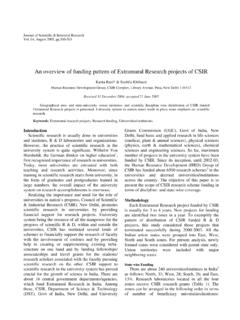Transcription of Chitin and chitosan: Chemistry, properties and applications
1 Journal of Scientific & Industrial Research Vol. 63, January 2004, pp 20-31 Chitin and chitosan : Chemistry, properties and applications Pradip Kumar Dutta*, Joydeep Dutta+ and V S Tripathi+ Department of Chemistry, Motilal Nehru National Institute of Technology, Allahabad 211 004 Chitin and chitosan are considerably versatile and promising biomaterials. The deacetylated Chitin derivative, chitosan is more useful and interesting bioactive polymer. Despite its biodegradability, it has many reactive amino side groups, which offer possibilities of chemical modifications, formation of a large variety of useful derivatives that are commercially available or can be made available via graft reactions and ionic interactions.
2 This study looks at the contemporary research in Chitin and chitosan towards applications in various industrial and biomedical fields. Keywords: Chitin , Biodegradability, chitosan , Biomaterials Introduction Chitin is the second most ubiquitous natural polysaccharide after cellulose on earth and is composed of (1 4)-linked 2-acetamido-2-deoxy- -D-glucose1 (N-acetylglucosamine) (Figure 1). It is often considered as cellulose derivative, even though it does not occur in organisms producing cellulose.
3 It is structurally identical to cellulose, but it has acetamide groups ( NHCOCH3) at the C-2 positions. Similarly the principle derivative of Chitin , chitosan is a linear polymer of (1 4)-linked 2-amino-2-deoxy- -D-glucopyranose and is easily derived by N-deacetylation, to a varying extent that is characterized by the degree of deacetylation, and is consequently a copolymer of N-acetylglucosamine and glucosamine (Figure 2). Chitin is estimated to be produced annually almost as much as cellulose.
4 It has become of great interest not only as an under-utilized resource but also as a new functional biomaterial of high potential in various fields and the recent progress in Chitin chemistry is quite significant. Chitin is a white, hard, inelastic, nitrogenous polysaccharide found in the exoskeleton as well as in the internal structure of invertebrates. The waste of these natural polymers is a major source of surface pollution in coastal areas. The production of chitosan from crustacean shells obtained as a food industry waste is economically feasible, especially if it includes the recovery of carotenoids.
5 The shells contain considerable quantities of astaxanthin, a caroteniod that has so far not been synthesized, and which is marketed as a fish food additive in aquaculture, especially for salmon. The chitinous solid waste fraction of average Indian landing of shellfish was ranged from 60,000 to 80,000 t. The three parts of our motherland, India, are surrounded by ocean and its inner land is also very much rich with ponds, lakes, and lagons.
6 The proper utilization of those water resources (aquaculture) in terms of research in Chitin and chitosan can bring the economic and academic prosperity of the nation. Chitin and chitosan are now produced commercially in India, Poland, Japan, the US, Norway and Australia. A considerable amount of research is in progress on Chitin / chitosan worldover, including India, to tailor and impart the required functionalities to maximize its utility. _____ * Correspondence author + University of Allahabad, Allahabad 211 002 e-mail : HNCOHNC OCH3 OHCH2 OHOHOHHHH2 OHCHOHHOHHHHCH3 Figure 1 Structure of Chitin OHOOHONH2xl ONHAcOOHHOy Figure 2 Partially deacetylated Chitin DUTTA et al.
7 : Chitin & chitosan 21 Chitin and chitosan the naturally abundant and renewable polymers have excellent properties such as, biodegradability, bio-compatibility, non-toxicity, and adsorption2. The reaction of chitosan is considerably more versatile than cellulose due to the presence of -NH2 groups. Various efforts have been made to prepare functional derivatives of chitosan by chemical modifications3, graft reactions, ionic interactions, and only few of them are found to dissolve in conventional organic solvents4.
8 chitosan is only soluble in aqueous solutions of some acids, and some selective N-alkylidinations3,5 and N-acylation4,6 have also been attempted. Although several water-soluble7 or highly swelling2 derivatives are obtained, it is difficult to develop the solubility in common organic solvents by these methods. Modification of the chemical structure of Chitin and chitosan to improve the solubility in conventional organic solvents has been reviewed by many authors8-13.
9 On the other hand, only a few reviews have been reported on biomedical applications of Chitin /chitosan14-16, and no comprehensive review has yet been published covering the entire range of applications . The present review covers the literature from 1993 to 2003 dealing with properties , processing, and applications in various industrial and biomedical fields. Chitin and chitosan Processing Chitin and chitosan are natural resources waiting for a market. They were waste products of the crabing and shrimp canning industry.
10 The US Department of Commerce reported in 1973 that they were over 1,50,000 Mt of Chitin produced as processing waste from shellfish, krill, clams, oysters, squid, and fungi. Commercially Chitin and chitosan are of great importance owing to their relatively high percentage of nitrogen ( per cent) compared to synthetically substituted cellulose. The crustacean shells mainly involves the removal of proteins and the dissolution of calcium carbonate that is present in crab shells in high concentrations.









